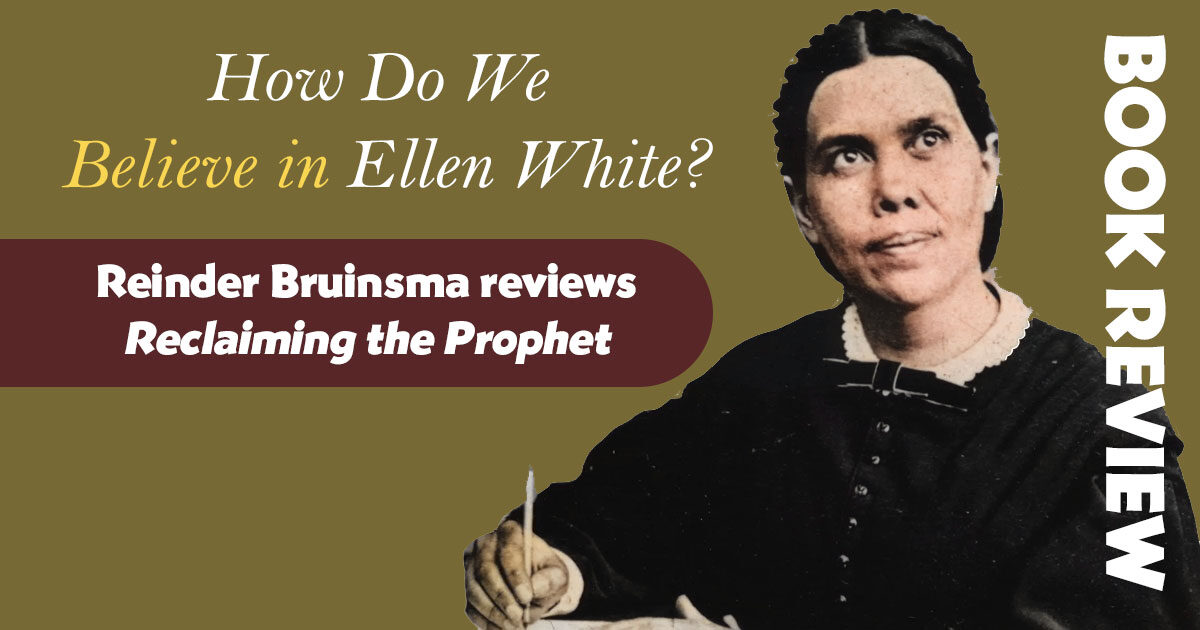Reclaiming the Prophet: How to Believe in Ellen White
by Reinder Bruinsma | 27 June 2025 |
Opening the third section of Reclaiming the Prophet, veteran Adventist historian George R. Knight recaps much of what he’s written in his other books about Adventist church history. He recounts how the original perspective on the ministry of Ellen White was, to a large extent, lost sight of during the rise of fundamentalism in American Protestantism in the 1920s and 1930s. What evolved, says Knight, was a new dominant perspective: that the human element in Ellen White’s work was almost fully eclipsed by her inspired status. (This is the primary point made by the author of the response by the Ellen White Estate.)
Contrary to what she herself, and those who knew her personally, had said, Ellen White began to be given the final say in doctrinal matters, and in the interpretation of biblical passages. The church began to affirm her to have been correct not just in spiritual interpretations, but in all her historical and scientific statements.
Knight emphasizes the thesis of Reclaiming the Prophet: the need to return to the earlier perspective on her writings that was held by Ellen White herself.
Ronald Graybill and Lawrence Geraty co-authored the chapter “Ellen White for Today: A Twenty-First Century Affirmation.” I want to stress how meaningful it is that these particular men wrote this affirmation. Geraty is a giant in modern Adventism, as a scholar and educational administrator. Graybill is without a doubt one of the most knowledgeable persons about the life and work of Ellen White, having worked as a staff member for thirteen years in the White Estate.
Historically, formulating the Fundamental Belief concerning Ellen White was a long and complex process—one of the hardest for the authors to get right. Fortunately, Geraty and Graybill remind us, the Preamble to the 28 Fundamental Beliefs allows for “finding better languages” to express our beliefs. The authors offer some suggestions about a possible rephrasing of that fundamental belief that better suits it to the current situation and the current scholarship. This is a valuable attempt to defuse much of the polarization around Ellen White’s person and work.
In a short final chapter, Niels-Erik Andreasen, another prominent scholar and academic leader, asks the question that underlies this entire project: “How can we move forward confidently while acknowledging new information about the prophet’s life and ministry?” (p. 158). Andreasen calls upon readers to make full allowance for the fact that Ellen White lived in a world that was vastly different from ours.
But this does not nullify the importance of her ministry. Andreasen concludes: “The best way to respond to that gap in time and location between hers and ours is by a thoughtful process of interpretation and application of her writings… as we have long done with the Scriptures” (p. 163).
Past turning points?
In this review of the main issues that are addressed in Reclaiming the Prophet, I must make special note of Eric Anderson’s chapter entitled “Turning Points,” in which the author points to four significant turning points in how Ellen White was viewed.
In the early 1880s, says Anderson, the nature of Ellen White’s inspiration became a controversial issue when a new edition of her Testimonies for the Church was prepared. Was it legitimate to make changes in the text in an effort to make it more readable? Or was every single word inspired and must therefore be left unchanged? In the process of resolving this matter, the idea of “verbal” inspiration was rejected. The importance of that first turning point can hardly be overstated.
The second turning point was in the 1880s: the recognition that Ellen White’s use of the work of other authors did not make her a false prophet. Even though the allegation of plagiarism would never fully disappear, the commotion about the similarities between her book about the apostle Paul and a book by another writer did not lead to her disqualification as a prophetic voice.
The third turning point occurred in the context of the 1911 revision of The Great Controversy, when numerous changes, including historical corrections, were made. The implication of this process was the recognition that Ellen White was not inerrant!
These were indeed significant “turning points.” But I believe Anderson will certainly agree with me that not all church members “turned” fully, or at the same time. Even today, Ellen White has admirers who take every single word that she wrote as not just inspired, but as inspired as is the Bible itself, and who choose to ignore the implications of her use of other authors while insisting that everything she wrote is historically and scientifically correct.
Sadly, the fourth turning point was not as complete as we may have wished. This happened in the 1970s, when views of Ellen White’s inspiration were gradually shifting. The shift came about after the reports of the 1919 Bible conference were discovered and published in Spectrum. Perhaps more significant were reactions to the bombshell of Ronald Numbers’ Prophetess of Health and Walter Rea’s The White Lie.
These were indeed turning points for many, myself included. The White Estate and denominational leaders only gradually and reluctantly conceded some of the arguments that were made. They by and large saw dissenting voices as hostile—merely sowing discord. And indeed, largely as a result of their failure to acknowledge the truths in these discoveries, discord resulted. The result of this attempt to hide the truth has been increased polarization.
Why the church needs this book
The authors of Reclaiming the Prophet did what the people at the White Estate should have done a long time ago: namely, inform the church about the results of the Ellen White research and design ways to continue benefiting from Ellen White’s ministry, while accepting well-established facts.
With many others in the church the authors of Reclaiming the Prophet understood that the church is at a critical point. A segment of the church is forcing Ellen White into a role she never aspired to, largely ignoring the results of recent scholarship that acknowledge her special giftedness but also point to the human elements in her life and ministry. This group tends not to use sound principles of interpretation, nor necessary common sense in applying her writing to the twenty-first century.
Meanwhile, another segment of the church has mostly turned away from Ellen White after having heard things they feel the church has purposefully tried to hide from them. In between is a large group which pays lip service to “the spirit of prophecy” as “a distinguishing mark of the remnant” without ever having read a word of what she wrote.
These eleven authors not only perceived that the church is at a critical juncture, but decided to do something about it. They produced this very insightful—critical but positive—book. It has all the makings of a true “turning point.” The White Estate and the church leadership ought to be extremely grateful for this honest and positive attempt to bring people together in a continued appreciation for the ministry of Ellen White.
I understand that recent books by Steve Daily and other critics will have caused ill feelings (even though I have wished some of the questions that have been raised would be answered!). But a book as this should be welcomed as part of a long overdue “turning point.”
A new turning point?
As I conclude these remarks, we are just a few days away from the General Conference session in St. Louis. I hope that the Spirit may be present at this gathering, and that it will refresh the climate in the church in such a way that we will lower the barriers between the various modalities in Adventism.
Could perhaps the ban on this book be lifted after all have returned home from St. Louis? Could Reclaiming the Prophet be given a chance to be a new turning point in our collective understanding of Ellen White?
It will no doubt take more than one book to bring us together. But it could be a beginning of a dialogue that will bring us back from the trenches in a spiritual war that will only have losers! My prayer is that this will happen.
 Reinder Bruinsma lives in the Netherlands with his wife, Aafje. He has served the Adventist Church in various assignments in publishing, education, and church administration on three continents. He still maintains a busy schedule of preaching, teaching, and writing. He writes at http://reinderbruinsma.com/.
Reinder Bruinsma lives in the Netherlands with his wife, Aafje. He has served the Adventist Church in various assignments in publishing, education, and church administration on three continents. He still maintains a busy schedule of preaching, teaching, and writing. He writes at http://reinderbruinsma.com/.
His latest book is Adventists and Catholics: The History of a Turbulent Relationship.




